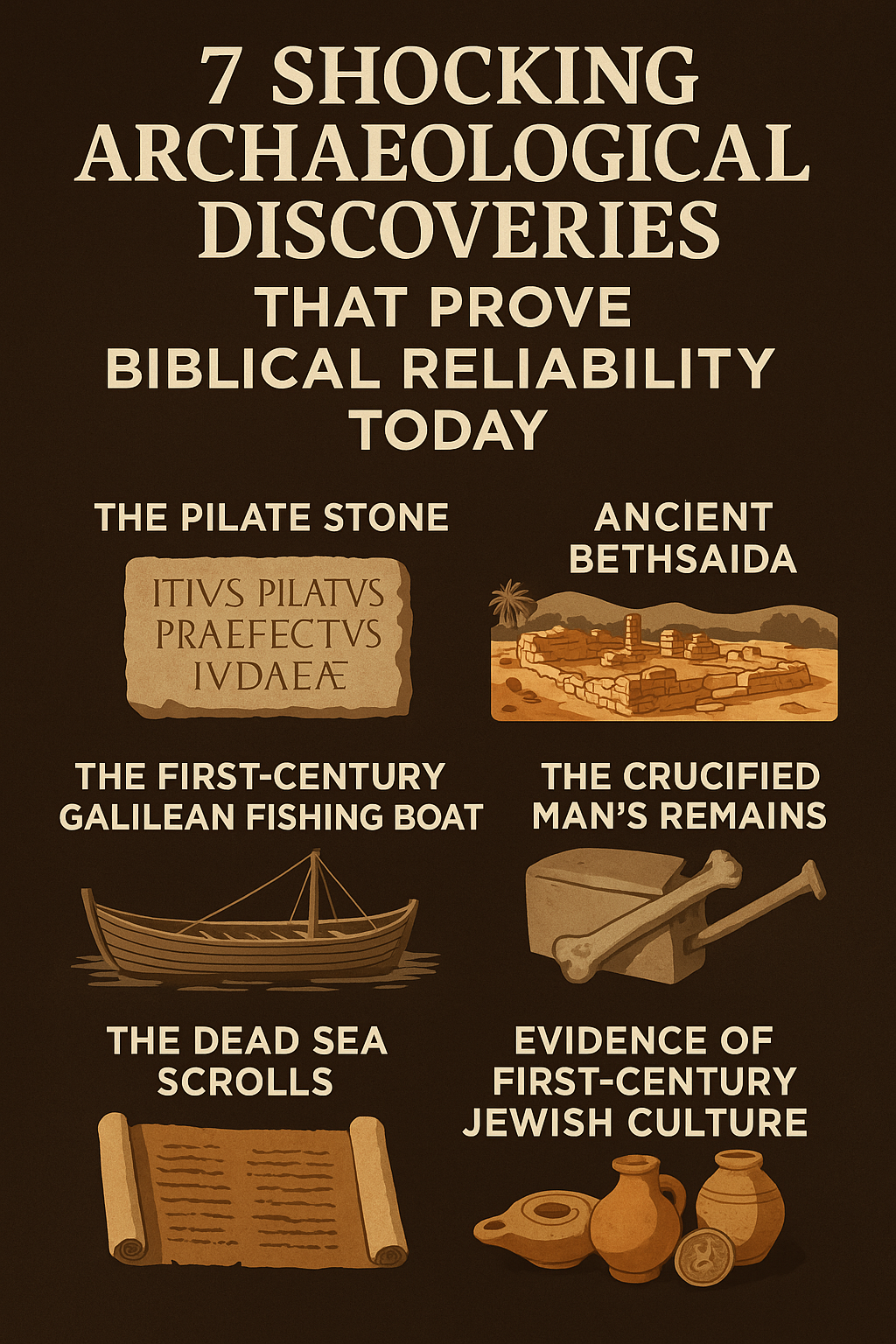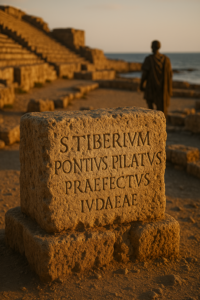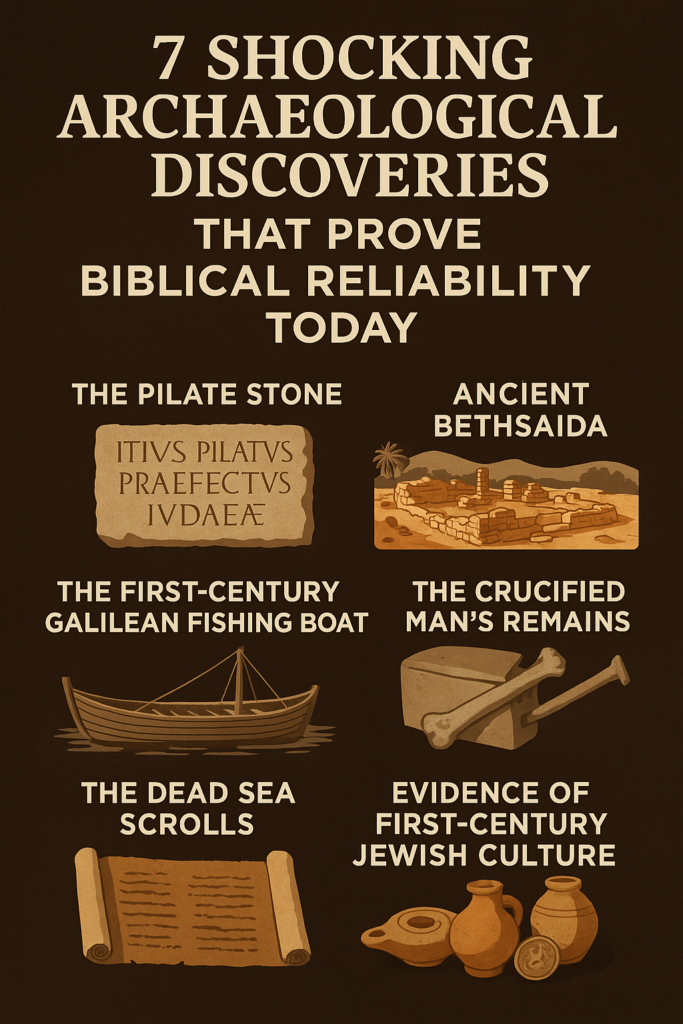
Estimated reading time: 15 minutes
Key Takeaways
- Archaeological discoveries like the Pilate Stone provide concrete evidence for biblical figures once dismissed as myths.
- The discovery of ancient Bethsaida confirms the geographical accuracy of Jesus’ ministry locations described in the Gospels.
- A 2,000-year-old fishing boat found in the Sea of Galilee matches the exact type described in biblical accounts.
- The Caiaphas Ossuary confirms the existence of the high priest who presided over Jesus’ trial.
- The Dead Sea Scrolls prove the Bible has been preserved with 95% word-for-word accuracy over thousands of years.
- Archaeological evidence of first-century Jewish culture confirms the historical context described in the New Testament.
- The Bible has stronger manuscript evidence than any other ancient document, with over 5,800 Greek manuscripts supporting its reliability.
Have you ever wondered if the stories in the Bible really happened? For centuries, people have debated whether the Bible is just a collection of myths or if it contains real history. Today, we have more answers than ever before!
Archaeologists (scientists who dig up old things) have found amazing objects buried in the ground that show many Bible stories are based on real people and places. These discoveries are changing how even non-religious experts view the Bible’s reliability.
In this article, we’ll explore seven incredible archaeological finds that support the Bible’s historical accuracy. Whether you’re a believer seeking confirmation or just curious about history, these discoveries will surprise you!
Archaeological Evidence Confirms Biblical Accounts
For many years, critics claimed that many people and places in the Bible never actually existed. They said these were just made-up stories. But over the last century, archaeologists have been busy digging in the Holy Land, and what they’ve found has shocked even the biggest skeptics.
Archaeological discoveries have repeatedly shown that the Bible gets many historical details exactly right. From the names of ancient kings to descriptions of ancient cities, the Bible’s accuracy has been proven time and again by shovels in the ground.
These findings don’t just support minor details – they back up major historical claims found in both the Old and New Testaments. Let’s look at seven of the most amazing discoveries that support biblical reliability.
The Pilate Stone: Proof of Pontius Pilate’s Existence
One of the most important characters in the story of Jesus’ crucifixion is Pontius Pilate. According to the Gospels (Matthew, Mark, Luke, and John), he was the Roman governor who ordered Jesus to be crucified.
For many years, some scholars questioned whether Pilate was a real person. That all changed in 1961 with an amazing discovery at Caesarea Maritima, an ancient Roman city on the coast of Israel.
Archaeologists found a large limestone block with an inscription that clearly mentioned “Pontius Pilate” and identified him as the “Prefect of Judea” – exactly as the Bible describes him! This stone was part of a building dedicated to the Roman Emperor Tiberius, who ruled during the time of Jesus.
This discovery proves that Pontius Pilate was:
- A real historical person
- Actually governing Judea at the exact time the Bible says
- Holding the exact position (prefect) that the Bible claims
The Pilate Stone is now displayed in the Israel Museum in Jerusalem. It stands as solid evidence that the Gospel writers were recording real history, not making up stories.
Ancient Bethsaida: Jesus’ Ministry Confirmed
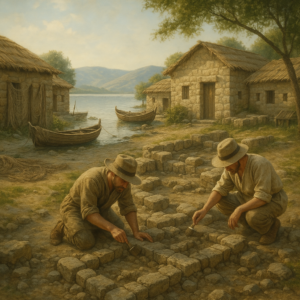 The Gospels tell us that Jesus spent much of his time teaching and performing miracles in fishing villages around the Sea of Galilee. One of these villages was called Bethsaida.
The Gospels tell us that Jesus spent much of his time teaching and performing miracles in fishing villages around the Sea of Galilee. One of these villages was called Bethsaida.
For many years, archaeologists weren’t sure exactly where Bethsaida was located. Some critics even suggested it might not have existed at all.
However, excavations at a site called et-Tell, near the northern shore of the Sea of Galilee, have uncovered the remains of what experts now believe is ancient Bethsaida. The discoveries include:
- Fishing equipment and hooks
- The foundations of houses from the first century (when Jesus lived)
- A village layout that matches the Gospel descriptions
What makes this discovery so important is that it confirms the Gospel writers knew the geography of Jesus’ ministry region very well. This supports the idea that they were either eyewitnesses themselves or got their information from actual eyewitnesses.
The excavations have also revealed that Bethsaida was indeed a fishing village, just as the Bible describes. This might seem like a small detail, but it shows the accuracy of the biblical accounts even in their casual descriptions of everyday life.
The First-Century Galilean Fishing Boat
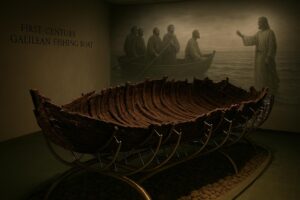 The Gospels often mention Jesus and his disciples crossing the Sea of Galilee in boats. In 1986, during a drought when the water level of the Sea of Galilee was unusually low, an amazing discovery was made.
The Gospels often mention Jesus and his disciples crossing the Sea of Galilee in boats. In 1986, during a drought when the water level of the Sea of Galilee was unusually low, an amazing discovery was made.
Buried in the mud near the shore, archaeologists found an ancient wooden fishing boat. Scientific testing showed this boat was from the time of Jesus – about 2,000 years ago!
The boat is 8.2 meters long and 2.3 meters wide – big enough to hold about 13 people. This matches perfectly with the Gospel accounts of Jesus and his 12 disciples traveling together by boat.
Here’s why this discovery is so important:
- It’s exactly the type of boat described in the Bible
- It confirms the fishing techniques mentioned in the Gospels
- It’s from precisely the right time period
- It shows the Gospel writers had accurate knowledge of boats used in first-century Galilee
The boat has been carefully preserved and is now displayed at the Yigal Allon Museum in Israel. Visitors can see for themselves this amazing connection to the world of Jesus and his disciples.
The Crucified Man’s Remains
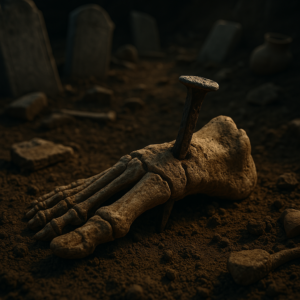 The Bible describes in detail how Jesus died by crucifixion – a Roman method of execution where the victim was nailed to a wooden cross. Some scholars questioned whether the Romans really used nails, suggesting they might have just tied victims to crosses with rope.
The Bible describes in detail how Jesus died by crucifixion – a Roman method of execution where the victim was nailed to a wooden cross. Some scholars questioned whether the Romans really used nails, suggesting they might have just tied victims to crosses with rope.
In 1968, construction workers in Jerusalem accidentally discovered an ancient tomb containing the bones of a man who had been crucified. Scientists determined he died around 70 AD, just a generation after Jesus.
What makes this discovery remarkable is that one of the man’s heel bones still had a large iron nail driven through it! The nail was bent at the end, showing how it had been hammered into wood.
This finding confirms several specific details from the Bible’s crucifixion account:
- Romans did use nails, not just ropes
- They nailed through the victims’ feet, just as described in the Gospels
- The practice of breaking the legs of crucifixion victims (mentioned in John 19:31-32) is confirmed by damage to this man’s leg bones
The discovery provides powerful evidence that the Gospel writers knew exactly what Roman crucifixion involved, supporting the idea that they were reporting actual events, not inventing stories.
The Caiaphas Ossuary: The High Priest’s Tomb
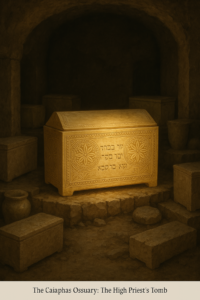 According to the Gospels, the Jewish high priest who helped condemn Jesus was named Caiaphas. For many years, there was little evidence outside the Bible that Caiaphas was a real person.
According to the Gospels, the Jewish high priest who helped condemn Jesus was named Caiaphas. For many years, there was little evidence outside the Bible that Caiaphas was a real person.
That changed dramatically in 1990 when construction workers in Jerusalem discovered an ancient family tomb. Inside were several bone boxes called ossuaries (where ancient Jews placed the bones of their dead after the flesh had decayed).
One beautiful, decorated ossuary had an inscription that read “Joseph, son of Caiaphas” – the full name of the high priest mentioned in the Gospels! Inside were the bones of a man who died in his 60s around the time of Jesus.
This discovery is significant because:
- It confirms Caiaphas was a real historical person
- It matches the time period described in the Bible
- The elaborate decoration of the ossuary shows he was indeed a wealthy and important person, fitting his role as high priest
The Caiaphas ossuary is now displayed in the Israel Museum in Jerusalem. This finding directly connects the Gospel narratives to real historical figures who actually lived in Jerusalem during the time of Jesus.
The Dead Sea Scrolls: Confirming Bible Preservation
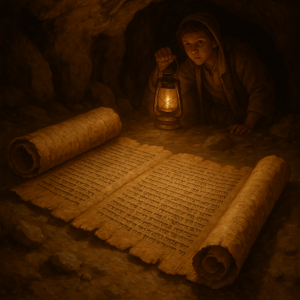 One common criticism of the Bible is that it changed over time as it was copied by hand century after century. Critics claimed the Bible we read today might be very different from the original writings.
One common criticism of the Bible is that it changed over time as it was copied by hand century after century. Critics claimed the Bible we read today might be very different from the original writings.
In 1947, a shepherd boy made one of the greatest archaeological discoveries of all time when he found ancient scrolls hidden in caves near the Dead Sea. These scrolls, dating from around the time of Jesus, contained parts of almost every book in the Old Testament.
When scholars compared these 2,000-year-old texts to our modern Bible, they were amazed to find they were almost identical! The Dead Sea Scrolls showed that the Bible had been copied with incredible accuracy over thousands of years.
The Isaiah Scroll, one of the most complete manuscripts found, is about 1,000 years older than any Bible manuscript we had before. When compared to today’s Book of Isaiah:
- 95% of the text is identical word for word
- The remaining 5% consists mostly of obvious spelling variations and minor scribal errors
- No major doctrines or stories are affected by these tiny differences
The Dead Sea Scrolls provide powerful evidence that the Bible we read today faithfully preserves the original ancient texts. This discovery removed one of the biggest arguments against biblical reliability.
Evidence of First-Century Jewish Culture
Some critics have claimed that the Gospels must have been written long after Jesus by people who didn’t understand Jewish culture in Jesus’ time. They say the Gospels show influences from Greek and Roman culture that Jews in Jesus’ day wouldn’t have accepted.
Archaeological discoveries have completely disproven this idea. Excavations throughout Israel have revealed that first-century Jews remained very strict in following traditional Jewish laws and customs.
Archaeologists have found:
- Coins from Herod’s time that avoid human images (following Jewish laws against “graven images”)
- Pottery that follows Jewish cleanliness laws
- Many ritual bathing pools (mikvahs) used for Jewish purification rituals
- No pig bones in Jewish settlements (showing they followed kosher laws)
- Tombs that follow strict Jewish burial customs
These findings match perfectly with the Jewish practices described in the Gospels. They show that the Gospel writers knew exactly how Jews lived in first-century Israel – something they could only know if they were either from that time and place themselves or got their information from people who were.
This evidence strongly suggests that the Gospels were written by people with firsthand knowledge of the events they describe, not by later writers who were making things up.
Historical Accuracy: The Bible’s Track Record
When we look at all these archaeological discoveries together, a clear pattern emerges: the Bible consistently gets historical details right. Places, people, customs, and events described in Scripture have repeatedly been confirmed by archaeological evidence.
As biblical archaeologist William F. Albright noted: “The excessive skepticism shown toward the Bible by important historical schools of the eighteenth and nineteenth centuries has been progressively discredited. Discovery after discovery has established the accuracy of numerous details.”
Many places once thought to be biblical myths have been discovered by archaeologists, including:
- The city of Jericho with evidence of its walls falling
- King David’s palace in Jerusalem
- The pool of Siloam where Jesus healed a blind man
- The ancient city of Nineveh where Jonah preached
- Solomon’s gates at Megiddo, Hazor, and Gezer
Each new archaeological discovery that aligns with biblical accounts adds to the Bible’s credibility as a historical document. While archaeology cannot prove every spiritual claim in the Bible, it has consistently confirmed the historical framework in which those spiritual events took place.
Textual Reliability: Ancient Manuscript Evidence
Another important aspect of biblical reliability is how accurately today’s Bible text reflects what was originally written. This is where the study of ancient manuscripts becomes crucial.
The New Testament has far more manuscript evidence than any other ancient document:
- Over 5,800 complete or partial Greek manuscripts exist
- Some fragments date to just 25-50 years after the original writings
- The earliest substantial portions date to around 200 AD
By comparison, other famous ancient works have far less manuscript support:
- Homer’s Iliad: about 1,900 manuscripts
- Works of Plato: fewer than 200 manuscripts
- Histories of Tacitus: only about 20 manuscripts
When scholars compare all these Bible manuscripts:
- 99% of the text is identical across all copies
- The differences are mostly minor spelling variations and obvious copying mistakes
- No core teaching or major event is affected by these variations
Biblical scholars Norman Geisler and William Nix concluded that the New Testament has a 99.5% purity rate in terms of textual accuracy. This is remarkable for any ancient document and gives us confidence that what we read today is essentially what the original authors wrote.
External Confirmation: Non-Biblical Sources
Archaeological discoveries aren’t the only evidence for biblical reliability. Several non-Christian writers from the first and second centuries also mention Jesus and early Christians, confirming key elements of the biblical accounts.
Flavius Josephus, a Jewish historian writing around 93-94 AD, mentions:
- Jesus and his brother James
- John the Baptist
- The execution of Jesus under Pontius Pilate
Roman historian Tacitus, writing around 116 AD, records:
- Christians named after “Christus” (Christ)
- Christ was executed under Pontius Pilate
- Christianity spread from Judea to Rome
Pliny the Younger, a Roman governor writing around 112 AD, describes:
- Christians worshiping Christ as God
- Their high moral standards
- Their regular meetings for worship
These non-biblical sources provide independent confirmation of key elements in the Gospel accounts. They show that even non-Christians of that time period acknowledged the existence of Jesus and the basic facts about his life and followers.
Prophetic Fulfillment: Predictions Come True
The Bible contains hundreds of prophecies (predictions of future events). Many of these prophecies were fulfilled with remarkable accuracy, adding another dimension to biblical reliability.
The Old Testament contains over 300 prophecies about the coming Messiah that Christians believe were fulfilled in Jesus’ life. Some examples include:
- His birth in Bethlehem (predicted in Micah 5:2, fulfilled in Matthew 2:1-6)
- His suffering and death as described in Isaiah 53
- The rebuilding of Jerusalem and the timing of the Messiah’s coming (Daniel 9)
What makes these prophecies significant is that they were written hundreds of years before Jesus was born. The Dead Sea Scrolls mentioned earlier prove that these predictions existed well before Jesus’ time – they weren’t added later to make it look like prophecies came true.
Other fulfilled Bible prophecies include:
- The destruction of Tyre (Ezekiel 26)
- The fall of Babylon (Isaiah 13, Jeremiah 51)
- The succession of world empires (Daniel 2, 7)
While interpretations of prophecy can vary, the specific nature of many biblical predictions and their historical fulfillment provides additional evidence for the Bible’s reliability.
Choosing a Reliable Bible Translation
With all this evidence for biblical reliability, you might wonder which English Bible translation best represents the original texts. Different translations have different strengths:
Word-for-word translations (formal equivalence):
- English Standard Version (ESV)
- New American Standard Bible (NASB)
- King James Version (KJV)
- New King James Version (NKJV)
These translations try to match the original Hebrew and Greek words as closely as possible.
Thought-for-thought translations (dynamic equivalence):
- New International Version (NIV)
- Christian Standard Bible (CSB)
- New Living Translation (NLT)
These translations focus on conveying the meaning of each sentence in natural English.
Paraphrase versions:
- The Message
- The Living Bible
These are more like retellings of the Bible in very modern language.
For studying biblical reliability, many scholars recommend using a word-for-word translation while consulting others for clarity. Using multiple translations can give you a fuller understanding of the text.
Why Biblical Reliability Matters Today
Understanding the historical reliability of the Bible is important for several reasons:
- It helps answer common questions and doubts about the Bible’s trustworthiness
- It provides a solid foundation for faith based on historical evidence, not just feelings
- It shows that biblical faith can be intellectually honest and open to historical investigation
- It helps us understand the Bible in its proper historical and cultural context
While archaeology and historical evidence cannot prove every spiritual claim in the Bible, they do show that the Bible is remarkably accurate when it comes to historical details. This gives us good reason to take its spiritual claims seriously.
As research continues, the historical reliability of the Bible keeps finding more support in archaeological discoveries and historical research. The evidence suggests that skepticism about biblical reliability often comes more from philosophical assumptions than from historical or archaeological evidence.
Conclusion: The Bible Stands the Test of Time
After reviewing seven shocking archaeological discoveries and other evidence for biblical reliability, we can see that the Bible has a strong claim to being historically trustworthy.
From the Pilate Stone to the Dead Sea Scrolls, physical evidence continues to support biblical accounts that critics once dismissed as myths. The extraordinary number of ancient biblical manuscripts gives us confidence that today’s Bible accurately reflects what was originally written.
Of course, historical reliability doesn’t automatically prove every theological claim in the Bible. Faith still plays an important role. But these discoveries do show that the Bible is firmly grounded in real history, with real people and places, not in mythology.
As archaeologist Nelson Glueck wrote: “It may be stated categorically that no archaeological discovery has ever controverted a Biblical reference. Scores of archaeological findings have been made which confirm in clear outline or in exact detail historical statements in the Bible.”
Next time you read the Bible, remember that you’re reading a book with remarkable historical credibility – one that continues to be vindicated by discoveries from the ancient world.
Frequently Asked Questions
How do we know the Bible hasn’t changed over time?
The Dead Sea Scrolls, discovered in 1947, contained biblical texts about 1,000 years older than any we had before. When scholars compared them to modern Bible texts, they were amazed to find they were 95% identical word-for-word, with the remaining 5% being mostly minor spelling differences. This proves the Bible has been copied with remarkable accuracy over thousands of years.
Has archaeology ever disproven any part of the Bible?
While archaeology cannot prove every detail in the Bible, it has consistently confirmed biblical people, places, and events once dismissed as myths. As archaeologist Nelson Glueck stated, “No archaeological discovery has ever controverted a Biblical reference.” Discoveries like the Pilate Stone, ancient Bethsaida, and the Caiaphas Ossuary have all confirmed biblical accounts.
Which Bible translation is most reliable?
For studying historical reliability, many scholars recommend using a formal equivalence (word-for-word) translation like the ESV, NASB, or NKJV, which stay closest to the original Hebrew and Greek texts. However, comparing multiple translations can provide a fuller understanding of the text. The best approach is to use a word-for-word translation for study and a thought-for-thought translation for readability.
Do non-Christian historical sources mention Jesus?
Yes, several non-Christian historians from the first and second centuries mention Jesus. Josephus (a Jewish historian), Tacitus (a Roman historian), and Pliny the Younger (a Roman governor) all reference Jesus and early Christians in their writings. These sources confirm key details from the Gospel accounts, including Jesus’ execution under Pontius Pilate.
How does archaeological evidence support New Testament reliability?
Archaeological discoveries have confirmed numerous New Testament details, including the existence of Pontius Pilate (the Pilate Stone), the high priest Caiaphas (the Caiaphas Ossuary), fishing villages like Bethsaida where Jesus ministered, and even details of Roman crucifixion (the crucified man’s remains). These findings show that New Testament writers had accurate knowledge of first-century Palestinian geography, culture, and historical figures.

